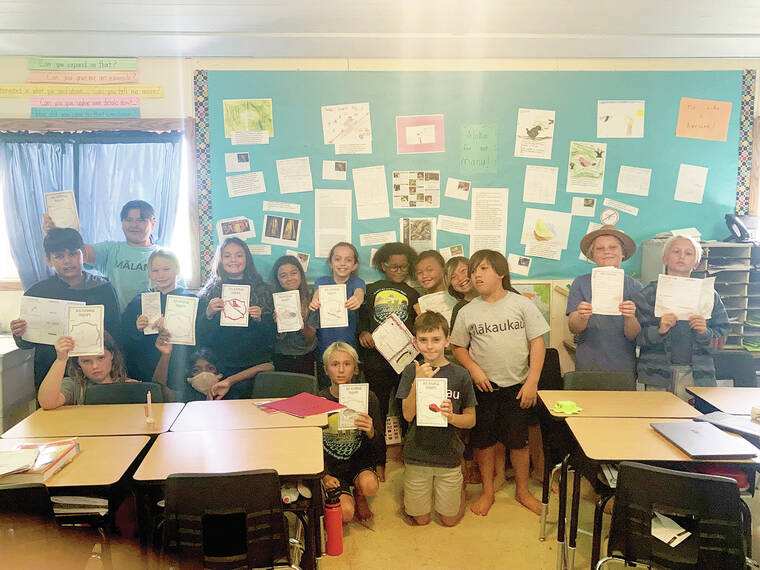ANAHOLA — A class of fourth grade students in Anahola are campaigning for members of Hawai‘i’s Legislature to create a statewide day recognizing and celebrating Hawai‘i’s threatened and endangered honeycreepers.
Students of Auntie Elizabeth Sancho at Kanuikapono Public Charter School have spent the past several weeks researching Hawaiian honeycreepers and their importance to the Aloha State. After researching the birds, they wrote out a call to action in support of recognizing Aug. 8 as Hawai‘i Honeycreepers Celebration Day across the state.
“We’re learning how, as fourth graders, we can make changes,” Sancho said. “Civics is one of our things that we have to learn, and so I thought, ‘This is perfect — we’ll work on this as a team.’ And we’ve all learned a lot about it.”
Throughout the course of the project, students learned how crucial the honeycreepers are to ecosystems across Hawai‘i.
“The reason we want to keep the honeycreepers alive is they keep the forests of Hawai‘i alive,” said Solomon, a student who researched the i‘iwi. “Some of them dig out insects, others help the forest by pollinating flowers.”
Pollination by honeycreepers have been found to assist the ‘ohi‘a seedset, helping the trees to propagate. In exchange, many honeycreepers feed primarily on nectar from ‘ohi‘a lehua blossoms and are only found to nest in ‘ohi‘a trees.
Additionally, students learned about the importance of the honeycreepers to Hawai‘i’s culture and history.
”(‘Elepaio) play an important role in Hawaiian mythology, because it was thought of as a guiding spirit for canoe makers,” said Halia, a student who researched the ‘elepaio. “Because sometimes, the ‘elepaio will follow hikers on the mountains to make sure they’re not in danger.”
Many honeycreepers’ feathers were also used to create capes for ali‘i, Hawai‘i’s traditional nobility. Violet, a student who researched the ‘elepaio, spoke about how this was done without hurting any of the birds.
“They would get sticky sap and put it on a tree branch, hide in a bush, and for the bird to land on it,” she said. “And their feet would get stuck, and they would just grab only a little feathers and let the birds go without them getting injured.”
However, these living parts of Hawaiian history are at risk of extinction. According to the U.S. Department of the Interior, four honeycreepers — the ‘akeke‘e and ‘akikiki on Kaua‘i, and the kiwikiu and ‘akohekoe on Maui — are in danger of extinction in as little as one to two years. In addition, eight other Hawaiian forest bird species risk extinction in the future if no action is taken.
Invasive southern house mosquitoes carrying avian malaria pose the greatest threat to Hawaiian forest bird species, according to the department. Because the mosquitoes can’t live in cooler environments, these birds have been forced up the mountainsides, to higher elevations too cold for mosquitoes.
“A long time ago, the birds used to be everywhere,” Violet said. “But now, they had to go up into the mountains, so there’s only a little of them now. There’s not much left.”
But as climate change increases air temperatures, the already limited habitable lands for Hawai‘i’s honeycreepers continue to shrink as mosquitoes march upward.
As the world risks losing these rare and iconic birds, Kanuikapono’s students are calling on the Hawai‘i Legislature to bring greater attention to the honeycreepers’ value — both to the ‘aina and culture of Hawai‘i.
The office of House Majority Leader Nadine Nakamura sent a positive message to the students in response to their efforts.
“We appreciate the 4th grade students of Kanuikapono for their research and sharing what they have learned,” wrote Angela Tumaneng, legislative aid for Nakamura’s office. “Representative Nakamure and our office enjoyed reading about the native birds and about how the students show that they care about the importance of these birds for the island of Kaua‘i.”
•••
Jackson Healy, reporter, can be reached at 808-245-0427 or jhealy@thegardenisland.com.



Thank you so much for coming to our classroom! The students were so proud to share their knowledge. We must show aloha for our manu!!